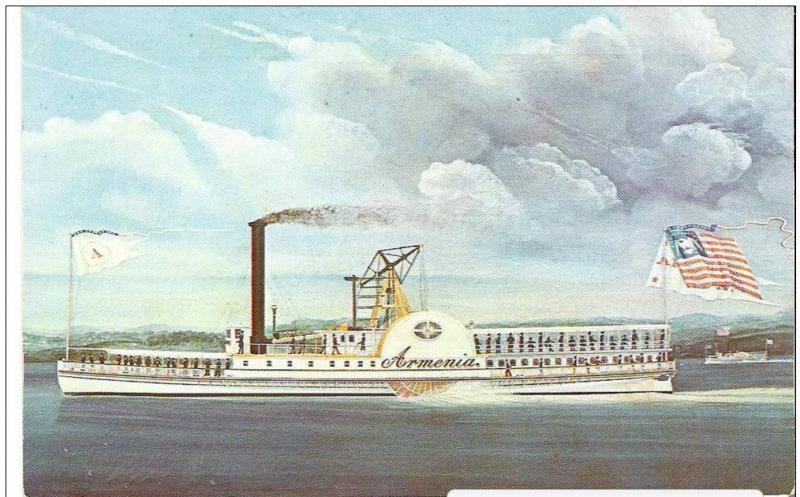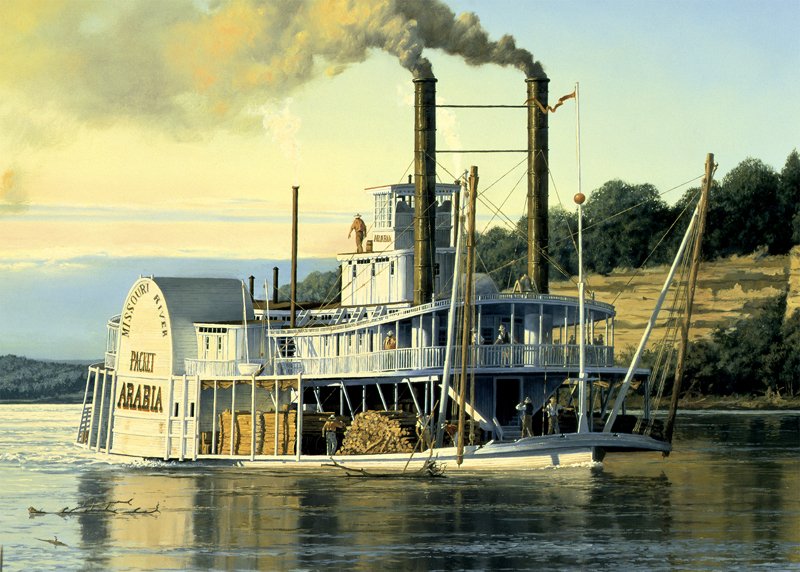Search the Community
Showing results for tags 'Riverboat'.
-
Hello all. This is my third build log here on MSW and will be my first attempt at scratch building a ship. The ship that I will be trying to build is a Hudson River sidewheeler named the Armenia. I acquired plans for this vessel through my local model club (Connecticut Marine Model Society) and there are two main reasons I decided to build her. First I found the ‘walking beam engine’ that drives her paddlewheels to be a fascinating piece of machinery; the second and maybe the more important is that the admiral likes her too. The original plans, by F. Van Loon Ryder dated 1954, are drawn at 1/8” (1:96) scale. There are four drawings detailing the ships profile, body lines, the engine, and different deck layouts and one sheet of technical specifications. The Armenia (1847-1886) was built by Thomas Collyer, New York. She had a wood hull; length 185 feet on deck, 187 feet overall; 28 feet molded beam, 50 feet extreme beam; depth 8 feet 6 inches; 391 tons. She was powered by a Henry Dunham vertical (walking) beam engine and had an unusually long stroke of 14 feet. The paddlewheels are 29 feet 4 inches in diameter an 8 feet 3 inch wide, turning at 23 rpm. In 1852 the Armenia was lengthened to 212 feet, increasing tonnage to 421; cylinder diameter increased to 42 inches; a second boiler added with second stack aft of the original stack and the typical guard posts and hog framing added. I will be modeling her original configuration. Since this is my first scratch build I’ve been a bit hesitant in starting her mainly because I wasn’t too sure of what material to use and how much of it I needed. After hemming and yawing for a few months I decided to do what I’ve done for the past 40 years and that’s to make my own drawings of the ship so I’d have a better understanding of just how she was built. I’ve only done building (structural) drawings but I think with the set of original drawings and a little help from the CMMC members and the people on this site I should be alright. For my set of drawings I decided to redraw them at 3/16” (1:64) scale instead of the original 1/8” scale. I thought it might be a little easier to build a slightly larger ship since the eyesight just ain’t what it used to be. At 3/16” scale the model will be approximately 35” long by 9 ½” wide. I also decided that instead of just making a set of 2-dimensional drawings I would try drawing this ship in 3-dimensional cad. I’m doing this for two reasons: One, since this is my first scratch build I will get a much better understanding of how the parts go together and secondly, I have used AutoCAD pretty much since its inception but only it’s 2-D capabilities so I thought to myself, self, maybe it’s time to learn something new. So I will be making a 3-D model of the ship before I attempt to physically build it. This should also save me from wasting a lot of material since it’s a lot easier to erase and redraw than it is to remake a number of pieces. Because I am drawing this ship in cad I thought it would be more appropriate to do so in the ‘CAD and 3D Modelling/Drafting Plans with Software’ forum on this site. So until I start the physical part of this build I will be continuing at the following link: http://modelshipworld.com/index.php/topic/14198-3-d-armenia-by-sald-–-hudson-river-sidewheeler-1847/?p=440043 I apologize for rambling on, like my daughter tells me “TLDR” (Too Long, Didn’t Read), but if anyone would like additional information about this ship please let me know, I’d be more than happy to send it or post it here. TO BE CONTINUED…..
-
The Arabia as envisioned by artist Gary Lucy; used with permission of the Arabia Steamboat Museum As a resident of rural Missouri, not far from its eponymous river, I've long been fascinated by the less-well-known steamboats that worked the “Big Muddy” from the river’s mouth at St. Louis all the way to the head of navigation at Fort Benton, Montana, an astounding 2,300 river miles. Most modern impressions of interior American steamboats are of the large, highly-decorated “floating wedding cake” craft of the lower Mississippi River, which represent a small fraction of the full diversity of steamboat design and use. Those craft are, to my eye, too gaudy by far, the equivalent of overbuilt Disney cruise liners; I don’t care for them, and I really don't care for the highly inaccurate and toylike models that most kits claim represent American riverboats. I prefer the smaller, leaner steamboats of the upper rivers, those designed to risk the rocky ledges of the Ohio River (such as the Chaperon) or fight their way up the narrow, shallow, ever-changing treacherous channels of the Missouri River. By the 1850s, their design had been nearly perfectly adapted to the unique conditions they faced, changing little for decades to come, until railroads finally cut them off at the knees. Two of the most well-known and well-documented steamboat wrecks from this period are the Bertrand (a sternwheeler that sank in 1865 and was rediscovered in 1968) and the Arabia (a sidewheeler that sank in 1856 and was rediscovered in 1988). Both boats now have excellent museums displaying their highly diverse and extraordinarily well-preserved cargo; the Bertrand at a wildlife refuge north of Omaha, Nebraska, and the Arabia at a museum in downtown Kansas City, Missouri. I began researching the Arabia in earnest in spring 2017, writing about and documenting my research and sources for information in a separate thread, but am now ready to begin building the actual model. The text above is copied and rearranged from that thread, but I felt it provided an important introduction to this project and so should be repeated for those who may not go back and read the research thread. Although I am far from a master modeler, this will be my third scratchbuilt Missouri River steamboat. I built a rudimentary version of the Far West when I first became interested in wooden ship modeling, and later tackled a fully-framed and interior-detailed version of the Bertrand. Both of those were built in 1:87, a comfortable scale for me as a former HO model railroader. However, for this project I wanted a new kind of challenge, so decided to build the Arabia in 1:64. The model will be around 32 inches (81 cm) long, allowing for more detail to be added overall. At the same time, though, I've decided not to recreate a fully-framed hull and interior as I did with Bertrand, for several reasons. First, that was a lot of work and material and would be even more expensive at 1:64, and I've already done that style now. Second, creating a framed model of Arabia would be both redundant and speculative; the museum preserves her stern intact for anyone to see, while the rest of the hull wasn't well-documented by the salvage team, so I'd be guessing more than I did with Bertrand (which was meticulously documented by an archeological team). Third, I just like the idea of a complete exterior model this time, trading a bit less interior detail for more focus on the overall appearance and higher detail allowed by the larger scale. Basically, this is just what I feel like doing this time, and doing a project the way you want to is part of what makes it engaging. Although my initial plan was to develop a full set of blueprints for this project, that effort has stalled. It just isn't working for me to spend that much time on a computer, which I already do professionally as a freelance science editor. I'd rather spend my downtime working with wood than with pixels. So I stopped after developing a basic outline of the project and will just dive in, holding the design in my head and in various rough sketches and notes. This is, in fact, an authentic way to proceed, as riverboats in this era weren't built from printed blueprints either (one reason few construction records exist) but were simply laid out and built by artisans on the frontier shores of the Upper Ohio River. So any mistakes or quirks I may build into my Arabia as I proceed from the seat of my pants will be, at worst, a tribute to the real vessel's construction. Above are my loose outlines of her design. The real Arabia was about 170' long and 30' wide (hull, not including the wheels) and drew about 5'. And the sketches from which I'm getting started. There is no definitive information on the shape of her hull, other than the stern-most portion, which I've based on photos and measurements I took at the museum. So for the rest I've adapted a representative hull profile for the era from Alan Bates' The Western River Steamboat Cyclopoedium. The wheel and its supporting cylinder timbers are drawn directly from measurements I took at the museum. Centered within these drawings is the central internal bulkhead/keel I've laid out. These riverboats didn't have external keels the way normal ships did; their bottoms were generally perfectly flat with a stronger internal keelson instead. In this case, I'll be laying out horizontal bulkheads against this longitudinal one, just like a regular plank-on-bulkhead build. Hopefully now that I've laid the keel, so to speak, I can keep progress coming steadily. Thanks for reading, and for offering any ideas, suggestions, and criticisms that come to mind. I'd sure appreciate it if anyone points out concerns or problems that I can either explain or correct as I go along, as again I'm not a master modeler, just an ambitious one. Table of Contents Below I link to posts starting various portions of the build. This is intended to help folks looking for information on specific aspects of steamboats or their modelling, or just those wanting to catch up on a certain section. I'll try to keep this updated as I go along. Framing the hull Guards and main deck framing Planking the hull Cylinder timbers & engines Planking the main deck Paddle wheels Boilers Main staircase & chimney breechings Framing the boiler deck & superstructure design Boiler pumps & other main deck details
- 599 replies
-
- sidewheeler
- arabia
-
(and 4 more)
Tagged with:
-
Well here we go It is a while since I have done anything like this and hopefully I will be able to craft as well as I used to I am also running a blog for this build at http://micklen32.blogspot.co.uk/ My previous builds were the Sergal Racehorse of which I have no record unfortunately Then in 2004 I built the Sergal Thermopylae. Whilst building this I built a web site which amazingly still exists at http://micklen.50megs.com/ Well that's me and my history Now some pictures of the parts and what work I have already accomplished
- 116 replies
-
- mississippi
- riverboat
-
(and 2 more)
Tagged with:
-
hi all i am totally new here so please forgive mistakes i have been building this ship for a long time and so am a long way on. she is loosely based on a Vic Smeed plan. i make aplologys in advance she is not upto the standard of work on here but i aim to learn ( also i am not really good at this internet stuff) once again i know its not up to the standard on here but i aim to learn.
-
OK, my next build is going to be the AL King of the Mississippi. Looking over the plans and photos I noticed that the bow bulwark has hawser holes. Being that you have the hawser holes wouldn't the riverboats have had anchors stowed somewhere? I have been doing research over the last week and cannot find an answer to my question. Can anyone give me some advice on this or a good place to do some research?
-
Ok, I realize that the OcCre Spirit of the Mississippi is a fictional rendition of a Mississippi Sternwheeler, so my question is more obstract than aimed at that specific ship. The question is when did such riverboats start to ply the Mississippi, and when did they first become floating casinos? The model depicts a full gaming facility, in nice detail, BUT, the flag it flies is a US flag with only 20 stars. That would indicate the year 1818, as the 20 star flag was only used for that one, year (Ok, from Dec 10, 1817). I didn't think steam riverboats had reached the level of luxury and function of the model depicted as the Spirit of the Mississippi, as early as 1818. I would have put this boat more into the mid to late 1800's rather than that early. Anybody have any idea's? Dave
- 2 replies
-
- mississippi
- riverboat
-
(and 1 more)
Tagged with:
About us
Modelshipworld - Advancing Ship Modeling through Research
SSL Secured
Your security is important for us so this Website is SSL-Secured
NRG Mailing Address
Nautical Research Guild
237 South Lincoln Street
Westmont IL, 60559-1917
Model Ship World ® and the MSW logo are Registered Trademarks, and belong to the Nautical Research Guild (United States Patent and Trademark Office: No. 6,929,264 & No. 6,929,274, registered Dec. 20, 2022)
Helpful Links
About the NRG
If you enjoy building ship models that are historically accurate as well as beautiful, then The Nautical Research Guild (NRG) is just right for you.
The Guild is a non-profit educational organization whose mission is to “Advance Ship Modeling Through Research”. We provide support to our members in their efforts to raise the quality of their model ships.
The Nautical Research Guild has published our world-renowned quarterly magazine, The Nautical Research Journal, since 1955. The pages of the Journal are full of articles by accomplished ship modelers who show you how they create those exquisite details on their models, and by maritime historians who show you the correct details to build. The Journal is available in both print and digital editions. Go to the NRG web site (www.thenrg.org) to download a complimentary digital copy of the Journal. The NRG also publishes plan sets, books and compilations of back issues of the Journal and the former Ships in Scale and Model Ship Builder magazines.



































